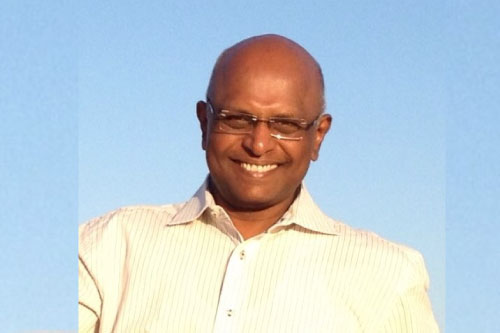Vijaya Kumar M.
CEO,
Webyfy IoT Private Limited
vijay@webyfy.com
Synopsis
IoT is the largest emerging technology market in the world. India has the largest technical manpower in the world. IoT is an amalgamation of multiple technologies – both hardware and software.
An open-source platform for IoT promoted by India can help to exponentially increase the development of IoT applications in multiple domains. It can also increase job opportunities in associated activities like manufacturing, assembly, implementation, operation, and maintenance. In addition, it can augment the development of chips for IoT and AI, and ML compliant with the open source platform.
Open-source IoT platform can be created through an amalgamation of independent functional modules with a common thread of compliance to standards and integrated processes running through them.
With some tweaking of the existing FOSS policy, implementation infrastructure, processes, and funding initiatives, the Government of India can significantly support this process and give a boost in creating hundreds of standard-compliant, cost-effective applications in every domain.
Webyfy has developed an IOT technology framework “REACH ” containing hardware and software which can create solutions automatically like assembling LEGO blocks.
IoT and its Market Potential
A closer look at the clichéd statement “change is the only permanent thing” reveals two aspects – first, the speed of change is accelerating and the next is increasing dependence of everything on each other. In this context, the Internet of Things (IoT) has achieved significant importance in interconnecting seemingly heterogeneous systems.
The technologies for IoT have been in existence for long but structuring and process interconnection is being explored in detail in recent times. Progress in technologies for handling extremely large quantities of data, ubiquitous intelligence, AI & ML, and an increase in last-mile equipment processing capability have facilitated increased the pace of adoption of IoT.
The Internet of Things as a technology has the potential to transform every work of life including healthcare, transportation, manufacturing, services, and agriculture. IoT technology facilitates devices to communicate with each other, gather/consolidate/analyze data, and make informed decisions, leading to increased efficiency, productivity, and cost savings.
IoT has the potential to become a $4-11 trillion market in near future, contributing 11% to the global economy, according to a McKinsey Global Institute report. According to a report by MarketsandMarkets, the IoT market in India is expected to grow at a CAGR of 28.2% from 2020 to 2025, reaching a market size of $15 billion by 2025. India has been identified as one of the fastest-growing IoT markets in the Asia Pacific region.
With the unique advantage of having large technical manpower, established infrastructure, the trend to discover newer technologies by Indian researchers, and the capability for lowering costs, India’s technology industry is uniquely positioned to make significant inroads into the IoT markets of the world.
Constituent technologies associated with IoT
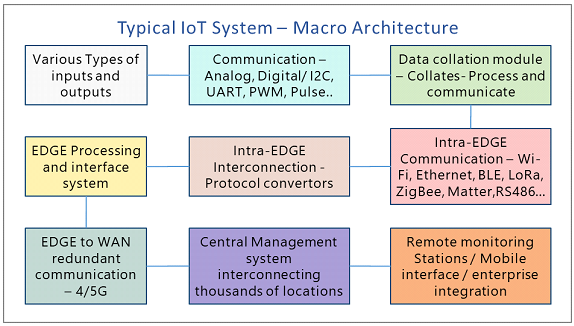
Normally an IoT system is referred to as a network of a large number of sensors and actuators. However, the system can interconnect any data generation or consumption point in a network. That means video, audio, and human / enterprise data interfaces can be termed EDGE device nodes in an IoT system.
A typical IoT system is an amalgamation of scores of technologies, contained in hardware or software subsystems. Integration of functionally heterogeneous modules and inter-module communication is the challenge in constituting an IoT system. The diagram gives a fair idea about the various technologies that go into an IoT system.
To get a deeper understanding of the complexities of an IoT system – especially when we tend to move into a generic architecture and open sourcing – let us sample the possible data communication methods and interconnections in an EDGE system. This is made obvious in the following diagram.
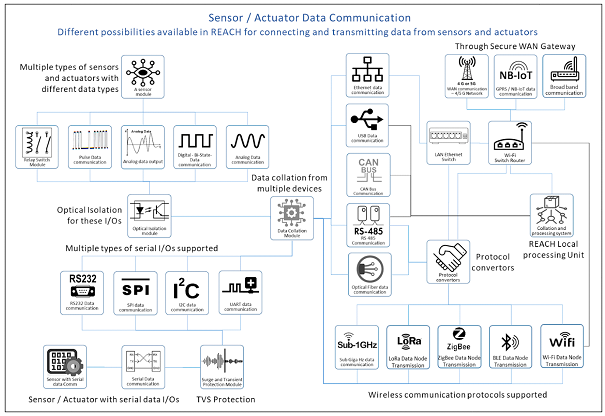
Even though the diagram seems complex, only one mode of communication is executed for a specific channel in an application. The diagram shows various possible requirements in varied applications. This kind of complexity needs to be considered when we talk about an open architecture and open sourcing of this technology.
Like every system, IoT is also a process-driven system. This makes it easier to split into functional or technology modules and manage them independently of each other, with an understanding of the relationship with upstream and downstream systems. This makes it easier for initiatives like open-sourcing the various technologies and functional modules.
IoT has a few distinct technology/ functional systems. (Hardware means hardware plus embedded software)
- Hardware – application sensors – (This contains Sensor element + data processing + data packaging + communication)
- Hardware – Data collation – Modules capable of collating and distributing data to various application sensors/ actuators with support for varied communication modes with application sensors/actuators.
- Hardware – Intra-EDGE Communication – Modules for various wired or wireless communication, with self-discovery and secure commissioning capability, Protocol converters to interconnect networks with heterogeneous communication protocols like interconnecting BLE mesh and Ethernet
- Hardware – EDGE processing module – Most applications use Raspberry Pi or similar modules based on the processing load. This can be made open-sourced with available low-cost processors
- Hardware – WAN communication and GPS modules – Redundant communication modules with 4 / 5 G and terrestrial communication.
- Software – EDGE processing systems based on EDGE network complexity and processing/accessibility requirements.
Software – Central management system – This contains several independent functional systems. - Software – Remote Monitoring stations from where the operators manage thousands of locations with control over individual locations.
- Software – Operator and mobile interfaces
- Hardware / Software – value-adding AI and ML components that can be plugged into the IoT system
The above modules are some of the significant subsystems in an IoT system. Each can be treated/developed independently with an understanding of the whole. Lower levels of componentization help in dividing the projects into multiple, independent effort groups with an understanding to integrate all under the same umbrella of open-source IoT.
It is obvious that we need to have a good coordination and monitoring organization constituted with a group of experts from multiple domains of technology and process competencies to effectively manage the project. Leadership can be provided by a company/organisation who are already into end-to-end IoT technology development.
Why should India promote open-source IoT platforms?
It is an undeniable fact that IoT is going to be the most influential Technology in the days to come and it has already started making its mark in every aspect of life. Even though it may seem that it will take away jobs, it can create hundreds of new jobs as it can make everyday activities more informed and efficient. The economic impact on society is humongous, especially for the agriculture and MSME sector which employs the maximum number of people. The operational efficiencies can be improved significantly, wastage reduced, improves collaboration and helps to make informed decisions.
India has the largest technical manpower in the world and IoT is going to be the largest Technology business in the world in the days to come. In addition, India has one of the largest markets. Hence India has to create strategies to reap maximum benefits not only from the use of IoT technologies but also from developing hundreds of IoT applications for multiple domains and becoming the world leader.
When we take a close look at IoT applications, we can see that they can be developed using a platform or a framework containing several Technology modules. The differences between applications are mostly the processes specific to the domain. So, if an extensive and scalable open-source IoT platform can be created, it can be leveraged to develop end-user applications quickly. This enables customers to realize the benefits of IoT at a lower cost at a faster pace.
And being a consumer of technology, India can quickly prove its products locally and convince the world to adopt the proven products, garnering a significant global market share. This shall also drive innovation in technology, especially in chip design for IoT / AI / ML, process (reengineering) consulting, and also developed a plethora of applications with a global standing.
Open source tools are cost-effective with no vendor lock-in, enable developers to create and change code to enhance their capabilities and performance, bring uniformity to APIs, enable code abstraction, and are easier to integrate with other tools, among many more benefits. Open-source frameworks improve interconnectivity and flexibility. There is freedom for unlimited customization and tuning the code to match the specific needs of a product.
Significant open IoT platforms are NodeMCU and ThingSpeak, which together hold a share of more than 70%, and are followed by FIWARE, Mobius, Kaa, OpenIoT, and ThingsBoard.
These can be taken as the base/model for taking the initiative forward.
How can this be done?
Any project has to take care of the stakeholders associated with it. A deep understanding of each stakeholder’s interest and involvement is a must for an effective project design and execution. The project Open Source IoT is no exception. Various stakeholders are shown in the figure.
One of the main discussion points when it comes to creating an open-source system is the standards and protocols that need to be followed. In the case of IoT, the National Telecom M2M Roadmap of India, first Published in May 2015, discusses adoption/partnership with OneM2M standards organization. This makes life easy when it comes to an open-source project for IoT.
IoT contains vast and varied technologies – both hardware and software. An open-source project in this arena may be conceived as a cluster of multiple, functionally / technologically independent projects with a common thread of standards compliance and integration capability.
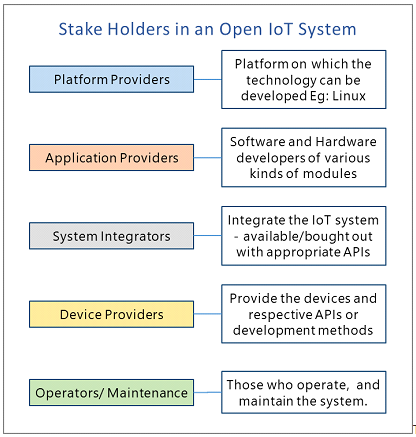
The platform shall involve sensors, actuators, data collection, movement, communication, analytics, decisions, operations, management, security, multimode access, and automation. All these need to scale to humungous levels.
The management of such a project must have a system for project management ensuring cooperation, collective empowerment, availability to solve issues, voluntary testing, and adoption of the technologies.
This means that only a group of people with a common interest to create an open-source IoT platform from varied fields of technology with the support of the government can spearhead such a developmental project. As the technology spectrum involved is very large and varied, a single organization managing the effort may be difficult.
And a few essentials are required from the governmental level to effectively make such an attempt. They are;
- A clear policy framework that outlines the regulatory environment for IoT
- Clear and definite directives on standards adoption
- Adopt or formulate policies on security, licensing, and ownership rights
- Even though the Government of India has had a FOSS policy since 2015, it is more focused on the promotion of its use rather than the development of FOSS by independent developers. So need a policy for the encouraging propagation of FOSS development among independent development communities/individuals/start-ups/academia.
- Funding Policy and Support. Considering the circumstances, individuals or companies can’t contribute effectively to such large projects which require concerted efforts, without any funding support.
- Guidelines for strengthening the collaboration between government, academia, and the private sector. While there are numerous initiatives aimed at promoting collaboration, there is still a significant disconnect between these different stakeholders especially on IP rights among other things.
The following are essential for an effective open sources project:
- Community creation
- Testing and experimentation
- Approvals and adoption
- Standards compliance
- Manage change/customization
- Scalability analysis and testing
- Documentation
- Enhance contributing talent pool
And it has become obvious from the above, it is not possible to have a single platform for Open source IoT but an integrated chain of modules that shall contain hardware and software functional modules. So, an umbrella organization may be constituted with the participation of the academia, government, private sector, Open Source India (OSI) community, and FOSS institutions of various state governments like ICFOSS of Govt. of Kerala. This functioning entity may spearhead the development.
This organization may not only coordinate and facilitate the eight points mentioned above but also facilitate the testing of modules and hardware components/modules developed by independent developers to be tested free of charge using the facilities of participating or otherwise academic institutions or other agencies.
They can also organize workshops, seminars, hackathons, and other events to bring together developers, investors, and industry experts. In addition, it can act as a nodal recommendation agency for funding specific projects in the arena.
The development of such a platform is critical for India to take the leadership position in the global IoT market with rapid, standard-compliant product development in hundreds of domains.
What IoT technology has Webyfy developed?
M/s. Webyfy IoT P Ltd is a start-up based in Thiruvananthapuram, Kerala, which is engaged in R&D in end-to-end IoT technology development including hardware and software.
A technology framework “REACH” has been developed to automatically generate customer-specific solutions by assembling the modules like LEGO blocks. A configuration engine creates the solution architecture and the rule engine defines its behaviour.
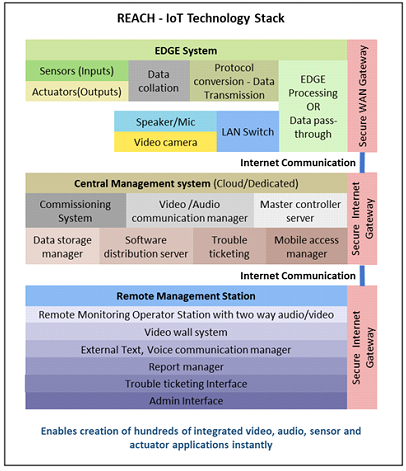
Webyfy IoT has not only integrated the sensors and actuators but also audio and video systems in the same technology framework. The applications are also geo-position aware and can be operated on mobile equipment/machinery. These multiply the number of applications that can be developed and the market size.
The diagram gives a summary of the technology developed by Webyfy in the past five years. The system is designed to be compliant with the One M2M standard and is being readied for certification.
Conclusion
IoT is the biggest emerging technology market in the world. India has the largest technical manpower in the world. IoT is an amalgamation of multiple technologies – both hardware and software.
An open-source platform for IoT promoted by India can help to multiply the development of IoT applications in multiple domains. It can also increase job opportunities in associated activities like manufacturing, assembly, implementation, operation, and maintenance. In addition, it can boost the development of chips for IoT and AI, and ML compliant with the open source platform.
Open-source IoT platform can be created through an amalgamation of independent functional modules with a common thread of compliance to standards and integrated processes running through them.
With some tweaking of the existing FOSS policy, implementation infrastructure, processes, and funding initiatives, the Government of India can greatly support this process and give a boost in creating hundreds of standard-compliant, cost-effective applications in every domain.

